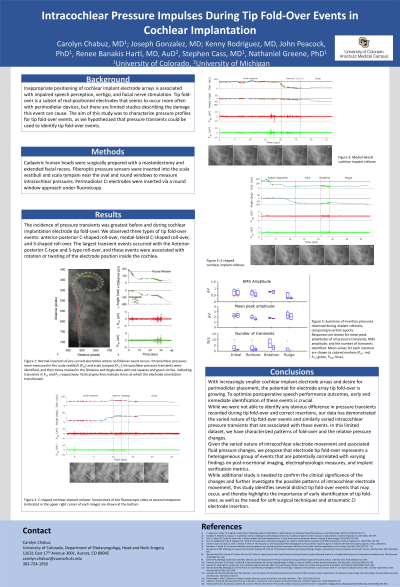Otology/Neurotology
(277) Intracochlear Pressure Impulses During Tip Fold-Over Events in Cochlear Implantation
Monday, October 2, 2023
2:45 PM - 3:45 PM East Coast USA Time

Has Audio

Carolyn A. Chabuz, MD
Resident physician
University of Colorado SOM
Denver, CO, United States
Carolyn A. Chabuz, MD
Resident physician
University of Colorado SOM
Denver, CO, United States
Presenting Author(s)
Co-Author(s)
Disclosure(s):
Carolyn A. Chabuz, MD: No relevant relationships to disclose.
Introduction: Malposition of a cochlear implant electrode array can be associated with impaired speech perception, vertigo, and facial nerve stimulation. Tip foldover is a subset of malpositioned electrodes that can occur with nearly all electrode types but occur most often with perimodiolar electrodes There are limited studies describing how or why tip foldover occur or the effects within the cochlea these events can cause. The aim of this study is to describe several ways that tip foldover can occur and correlate the physical events occurring during tip foldover with their associated intracochlear pressure profiles.
Methods: Cadaveric human heads were surgically prepared with a mastoidectomy and extended facial recess between 2019 and 2022. Fiberoptic pressure sensors were inserted into the scala vestibuli and scala tympani near the oval and round windows to measure intracochlear pressures. Perimodiolar CI electrodes were inserted via a round window approach under fluoroscopy. The fluoroscopy recordings were analyzed frame by frame to identify the position of the electrode in each frame using custom MATLAB scripts.
Results: We identified three types of tip foldover events, including: Anterior-posterior C-shaped roll-over, medial-lateral roll-over and S-shaped roll-over. The largest pressure transient events occurred with the Anterior-posterior C-type and S-type roll-over. Rotation or twisting of the electrode tip during tip foldover was associated with increased rate and amplitude of pressure transients and was different for each type of rollover event.
Conclusions: These results provide the first descriptions of several tip foldover events and their insertion pressure profiles during cochlear implant electrode array mis-insertion. Further investigation is required to determine if the abnormal pressure profiles demonstrated correlate with adverse histologic and physiologic changes within the cochlea.
